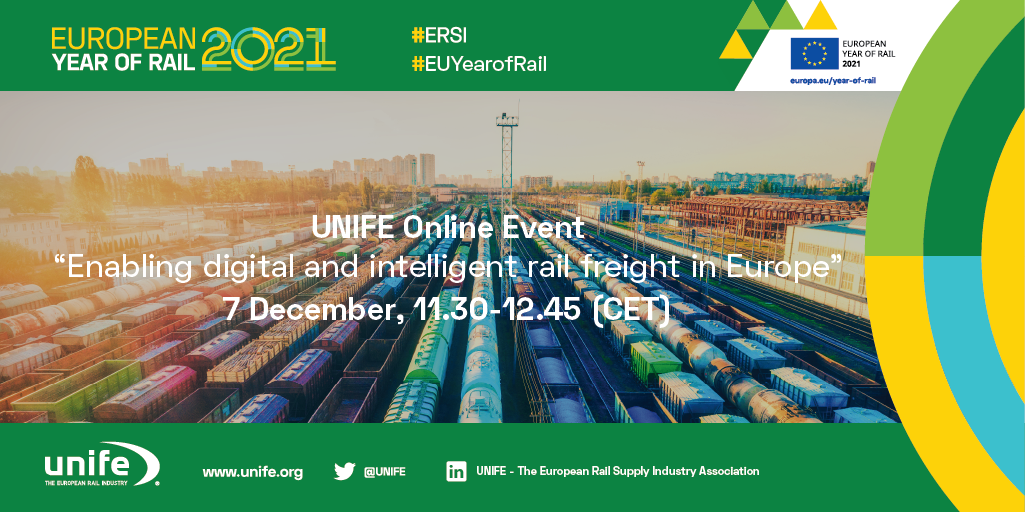Press Release: Enabling digital and intelligent rail freight in Europe
Most people are most familiar with passenger trains, but there is another side of the rail supply industry that is just essential to their everyday lives – freight. Rail is a central part of Europe’s current logistics ecosystem, a component of the complex and multimodal system that moves goods that enable modern European life and the economic opportunities that underwrites it. However, at the moment, our current freight paradigm is significantly contributing to climate change. As the second most emitting sector after energy production, European mobility must be decarbonised. Recognising rail’s unique attributes of not only producing less than 1% of transport’s emissions while becoming both greener and capable of conveying more materials, the Sustainable and Smart Mobility Strategy has called on doubling rail freight by 2050, in line with the EU Green Deal’s stated goal of creating a modal shift to help the EU become carbon neutral by the same year.
Held on 7 December 2021 and organised by UNIFE as part of “The European Year of Rail” campaign, this event was an opportunity to assess the importance of rail freight for reaching the European Commission’s climate and digitalisation targets with high level representatives from the European Parliament, the Shift2Rail Joint Undertaking (S2R JU), the European Union Agency for Railways (ERA), Siemens Mobility and Wabtec. Panelists focused on how the sector’s technology and innovation efforts have progressed through their engagement with the exciting European DAC Delivery Programme (EDDP), conducted under the S2R JU umbrella. As the conversation turned to explore the priorities and strategy of the institutionalised partnership’s successor, Europe’s Rail Joint Undertaking (ERJU). In particular, speakers were optimistic about the programme as a recent announcement demonstrated its commitment to this topic with its new fifth flagship area - “Sustainable Competitive Digital Green Rail Freight Services”. At the conclusion of the conversation, moderated by Railway Gazette Editor-in-Chief Chris Jackson, participants discussed, from a system perspective, the visions and challenges to digital and intelligent rail freight in Europe and their implications for achieving a significant modal shift by 2050 as envisioned by the EU Green Deal.
Anna Deparnay-Grunenberg, Member of the European Parliament, communicated the need for greater competition in the logistics sector: “In order to make the shift to rail a reality, first of all we need fair competition between the modes of transport. However, it is equally important that rail freight transport is brought up to the state of the art to be competitive point.”
Carlo Borghini, Executive Director of the Shift2Rail Joint Undertaking and the upcoming Europe’s Rail programme, highlighted the need to focus on emerging technologies: “Digitalisation and automation of train operations carry huge performance benefits for rail, leveraging on existing infrastructure while also upgrading it. Rail Freight may be the segment that will benefit more from such transformation as the opportunity of growth is huge. Nevertheless, this is not sufficient: digitalisation and intelligence benefits will be jeopardised if we do not intervene with a system approach to address many other barriers still present, such as border checks and controls, some national operational rules, time to market, etc. The Europe’s Rail partnership, which will start its full operations during 2022, is committed to support rail freight sector to deliver, with an ambitious roadmap, the expected technological and operational solutions.”
Josef Doppelbauer, Executive Director of the European Union Agency for Railways (ERA), explained the importance of data management for the future of freight: “Rail freight needs a system-wide change to be digitally integrated with intermodal transport chains – seamless movement of trains and accurate and timely information will help to increase the rail modal share”.
Christoph Klose, Head of Yard Solutions at Siemens Mobility, Co-leader of EDDP Work Package 1, emphasised the need for rail freight innovation by saying: “The digital freight train, as well as the seamless management of rail freight, in Europe is essential to increase the competitiveness of the rail freight.”
Roberto Tione, VP Technology Innovation at Wabtec, stated that: “The EDDP Flagship Area “Sustainable Competitive Digital Green Rail Freight Services" is the greatest, and perhaps the last opportunity for the railways stakeholders, IM/RU and Industry, to make Rail Freight the most efficient and preferable tool for freight transport in Europe. The challenge is not only technological, it will be necessary to generate in parallel new European operational standards linked to the new ways of operating freight trains offered by this immense technological leap”
Philippe Citroën, Director General of UNIFE, concluded the session by stressing the central role rail freight will play in the future of a carbon neutral Europe: “Doubling rail freight by 2050 will be an essential development for achieving net zero by midcentury. It will transform how Europeans across the continent receive goods and conduct business. To achieve this transition, the European institutions and Member States must provide significant investments and remain committed to research and innovation initiatives like Shift2Rail.”
See the event recording below
